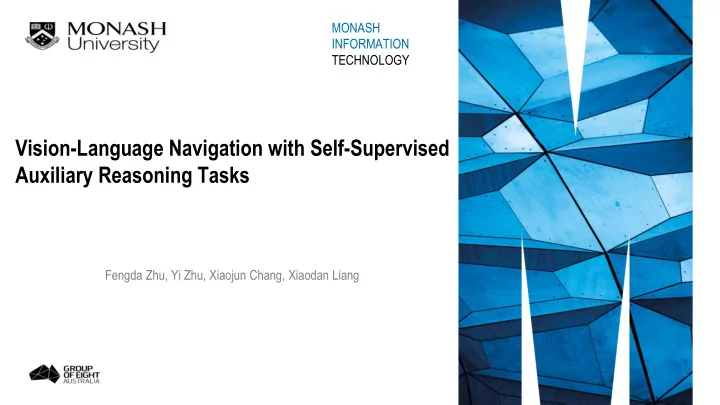

MONASH INFORMATION TECHNOLOGY Vision-Language Navigation with Self-Supervised Auxiliary Reasoning Tasks Fengda Zhu, Yi Zhu, Xiaojun Chang, Xiaodan Liang
Outline 1. Embodied Navigation 2. Vision-language Navigation Task 3. Related Works 4. Our Methods 5. Conclusion
Embodied Navigation Problem 1. datasets providing 3D assets with semantic annotations 2. simulators render these assets and simulate an embodied agent 3. tasks that define evaluable problems that enable us to benchmark scientific progress
Synthetic Image / Real Image Advantage Advantage • • More data Close to real application • Faster rendering Disadvantage • Disadvantage Less data • • Limited application Easily Overfitting Transfer: Sim-Real Joint Reinforcement Transfer for 3D Indoor Navigation (by Zhu et al. CVPR 2019)
Matterport3D
Habitat Simulator A flexible, high-performance 3D simulator with configurable agents, multiple sensors, and generic 3D dataset handling (with built-in support for MatterPort3D, Gibson, Replica, and other datasets). Advantage: • Real image • Fast rendering • Continuous action space Disadvantage: • Low rendering quality
PointGoal Task
ObjectGoal Task
Vision Language Navigation (VLN) Task Room-to-room (R2R) dataset • 90 houses • 7k trajectories • 21k instructions Computer Vision + Natural Language Processing • Natural Language + Reinforcement Learning • More detailed description • Require complex scene understanding
VLN baseline (seq-to-seq) Disadvantage: 1. Supervised learning is easily overfitting 2. Does not sufficiently exploit the panoramic view 3. The action space is redundant 4. Training-testing domain gap
Speaker-Follower Model Speaker: trajectory to instruction Follower: instruction to trajectory
Speaker-Follower Model
Reinforced Cross-Modal Matching (RCM) Advantage: 1. Use cross-modal attention 2. Introduce RL+ supervised learning
Environmental Dropout (Envdrop)
Self-Supervised Auxiliary Reasoning Tasks Please turn left and walk through the living room. Exit the room and Rich information to explore: turn right into the bedroom. • Semantics of the route 𝑝𝑏𝑚 • Navigation Progress • Vision Language Consistency 𝑢 2 • Room Structure 𝑢 1 Navigation Node 𝑢 0 Navigation Edge Feasible Edge
Self-Supervised Auxiliary Reasoning Tasks Please turn left and walk through the living room. Exit the room and We require the agent to: turn right into the bedroom. • Interpret its actions 𝑝𝑏𝑚 • Reason about the past • Align Vision-language explicitly 𝑢 2 • Predict the future 𝑢 1 Navigation Node 𝑢 0 Navigation Edge Feasible Edge
Self-Supervised Auxiliary Reasoning Tasks
Self-Supervised Auxiliary Reasoning Tasks
Self-Supervised Auxiliary Reasoning Tasks
Self-Supervised Auxiliary Reasoning Tasks Demo Code
Thank You
Recommend
More recommend